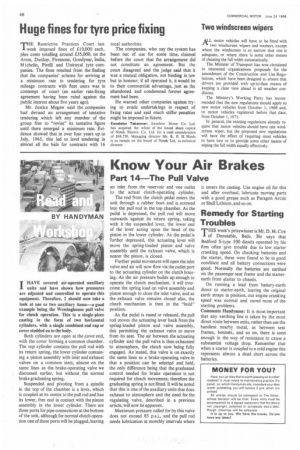Know Your Air Brakes
Page 50

If you've noticed an error in this article please click here to report it so we can fix it.
Part 14—The Pull Valve
I HAVE covered air-operated auxiliary units and have shown how pressures are adjusted and controlled to operate this equipment. Therefore, I should now take a look at one or two auxiliary items—a good example being the Westinghouse pull valve for clutch operation. This is a single-piece casting in the form of two horizontal cylinders, with a single combined end cap or cover studded on to the body.
Both cylinders are open at the cover end, with the cover forming a common chamber. The top cylinder contains the pull rod with its return spring, the lower cylinder containing a piston assembly with inlet and exhaust valves on a common stem, almost on the same lines as the brake-operating valve we discussed earlier, but without the normal brake graduating spring.
Suspended and pivoting from a spindle in the top of the chamber is a lever, which is coupled at its centre to the pull rod and has its lower, free end in contact with the piston assembly in the lower cylinder. There are three ports for pipe connections at the bottom of the unit, although for normal clutch operation one of these ports will be plugged. leaving an inlet from the reservoir and one outlet to the actual clutch-operating cylinder.
The rod from the clutch pedal enters the unit through a rubber boot and is screwed Into the pull rod in the top chamber. As the pedal is depressed, the pull rod will move outwards against its return spring, taking with it the suspended lever, the lower end of the lever acting upon the head of the piston in the lower cylinder. As the pedal is further depressed, this actuating lever will move the spring-loaded piston and valve assembly until the exhaust valve, which is nearer the piston, is closed.
Further pedal movement will open the inlet valve and air will now flow via the outlet port to the actuating cylinder on the clutch housing. As the air pressure builds up enough to operate the clutch mechanism, it will overcome the spring load on valve assembly and piston enough to close the inlet valve, and as the exhaust valve remains closed also, the clutch mechanism is then in the "hold" position.
As the pedal is eased or released, the pull rod moves the actuating lever back from the spring-loaded piston and valve assembly, this permitting the exhaust valve to move from its seat. The air between the actuating cylinder and the pull valve is then exhausted to atmosphere, the clutch now being fully engaged. As stated, this valve is on exactly the same lines as a brake-operating valve in that a position can be selected and held, the only difference being that the graduated control needed for brake operation is not required for clutch movement; therefore the graduating spring is not fitted. It will he noted that this is one of the auxiliary units that does exhaust to atmosphere and the need for the regulating valve, described in a previous article, will now he apparent.
Maximum pressure called for by this valve does not exceed 85 p.s.i., and the pull rod needs lubrication at monthly intervals where it enters the casting. Use engine oil for this and after overhaul, lubricate moving parts with a good grease such as Paragon Arctic or Shell Lithium, and so on.
Remedy for Starting Troubles
THIS week's prizewinner is Mr. D. M. Cox of Dunstable, Beds. He says that Bedford S-type 300 diesels operated by his firm often give trouble due to low starter cranking speed. On checking batteries and the starter, these were found to be in good condition and all battery connections were good. Normally the batteries are earthed on the passenger-seat frame and the starterearth from starter to chassis.
On running a lead from battery-earth direct to starter-earth, leaving the original earth straps in position, our engine cranking speed was normal and cured most of the starting problems.
Comments Handyman: It is most important that any earthing line is taken by the most direct route between units, rather than use the handiest nearby metal, as between seat frames, bonnets, and so on, there is soon enough in the way of resistance to cause a substantial voltage drop. Remember that when a starter is coupled to a cold engine this represents almost a dead short across the batteries.
























































































































